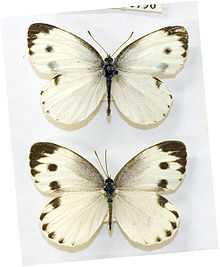Pieris canidia
| Pieris canidia | |
|---|---|
 | |
| Scientific classification | |
| Kingdom: | Animalia |
| Phylum: | Arthropoda |
| Class: | Insecta |
| Order: | Lepidoptera |
| Family: | Pieridae |
| Genus: | Pieris |
| Species: | P. canidia |
| Binomial name | |
| Pieris canidia (Sparrman, 1768) | |
The Indian cabbage white (Pieris canidia) is a butterfly in the family Pieridae. Pieris rapae is one of the closest species in the pieridae family.
Description
- See glossary for terms used
-_Female_on_Synedrella_nodiflora_at_Kolkata_W_IMG_3710.jpg)
Male has the upperside white to pale cream-colour. The base of the fore wing and the basal portion of the costa, and base and upper margin of cell with a scattering of black scales; apex and terminal margin to about the middle, decreasingly, black, on the latter the black extended for n very short distance triangularly along the veins ; a round black spot in interspace 3. The hindwing has a subcostal black spot as in Pieris rapae but is generally larger and more conspicuous, and a series of four or five terminal black spots that vary in size at the apices of the veins.
_I_Picture_255.jpg)
Underside : fore wing white ; cell and costa lightly irrorated with black scales; apex somewhat broadly tinged with ochraceous yellow; interspaces 1, 3 and 5 with conspicuous subquadrate black spots, the spot in interspace 1 sometimes extended into interspace 1 a, that in 5 ill-defined. Hind wing : from pale, almost white, to dark ochraceous, thickly irrorated all over (with the exception of a longitudinal streak in the cell, and in the darker specimens similar longitudinal streaks in the interspaces) with black scales ; costa above vein 8 chrome-yellow. Antennae black with minute white specks ; the long hairs on head and thorax greenish-grey; abdomen black ; beneath : head, thorax and abdomen white.
Female has the underside similar to that of the male but the scattering of black scales more prominent, the black on the apex and termen of the fore wing and the black spots on the termen of the hind wing broader, more extended inwards; on the fore wing there is an additional spot in interspace 1, and both this and the spot in interspace 3 in many specimens are connected by a line of black scales along the veins to the outer black border ; also the spot in interspace 1 often extends across vein 1 into the interspace below.[1]
Has a wing expanse of 42–60 mm.
Distribution
Sub-Himalayan India and Pakistan from Chitral, Kashmir to Sikkim and Bhutan, from 2000 to 11,000 ft (3,400 m). elevation ; the hills of Southern India; Assam; Upper Myanmar: the Shan States; extending to China.[1]
Gallery
-
_on_Tridex_procumbens_at_Samsing%2C_Duars%2C_West_Bengal_W_IMG_6285.jpg)
on Tridax procumbens at Samsing in Darjeeling district of West Bengal, India.
-
_on_Coffea_benghalensis_at_Jayanti%2C_Duars%2C_West_Bengal_W_Picture_085.jpg)
on Coffea benghalensis at Jayanti in Buxa Tiger Reserve in Jalpaiguri district of West Bengal, India.
-
-_Female_on_a_Synedrella_nodiflora_(Cinderella_weed)_W_IMG_3709.jpg)
Female on a Synedrella nodiflora (Cinderella weed) in Kolkata, West Bengal, India.
-
_on_Eupatorium_odoratum_at_Samsing%2C_Duars%2C_West_Bengal_W_IMG_6381.jpg)
on Eupatorium odoratum at Samsing in Darjeeling district of West Bengal, India.
-
_at_Samsing%2C_Duars%2C_West_Bengal_W_IMG_6308.jpg)
at Samsing in Darjeeling district of West Bengal, India.
-
_at_Jayanti%2C_Duars%2C_West_Bengal_W_Picture_088.jpg)
at Jayanti in Buxa Tiger Reserve in Jalpaiguri district of West Bengal, India.
-
_at_Jayanti%2C_Duars%2C_West_Bengal_W_IMG_5571.jpg)
at Jayanti in Buxa Tiger Reserve in Jalpaiguri district of West Bengal, India.
-
_on_Leucas_sp._at_Jayanti%2C_Duars%2C_West_Bengal_W_Picture_293.jpg)
on Leucas sp.at Jayanti in Buxa Tiger Reserve in Jalpaiguri district of West Bengal, India.
-
_on_Coffea_benghalensis_at_Jayanti%2C_Duars%2C_West_Bengal_W2_Picture_085.jpg)
on Coffea benghalensis at Jayanti in Buxa Tiger Reserve in Jalpaiguri district of West Bengal, India.
See also
Notes
References
- Evans, W.H. (1932) The Identification of Indian Butterflies. (2nd Ed), Bombay Natural History Society, Mumbai, India
- Gaonkar, Harish (1996) Butterflies of the Western Ghats, India (including Sri Lanka) - A Biodiversity Assessment of a threatened mountain system. Journal of the Bombay Natural History Society.
- Gay,Thomas; Kehimkar,Isaac & Punetha,J.C.(1992) Common Butterflies of India. WWF-India and Oxford University Press, Mumbai, India.
- Kunte,Krushnamegh (2005) Butterflies of Peninsular India. Universities Press.
- Wynter-Blyth, M.A. (1957) Butterflies of the Indian Region, Bombay Natural History Society, Mumbai, India.